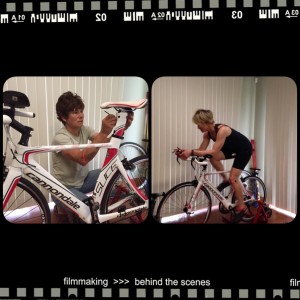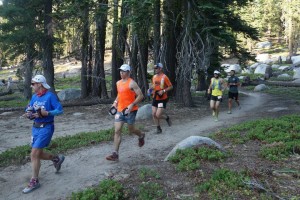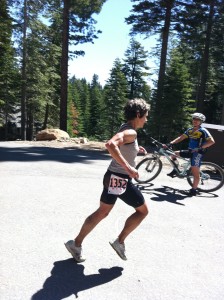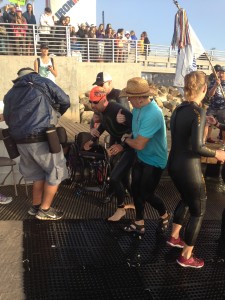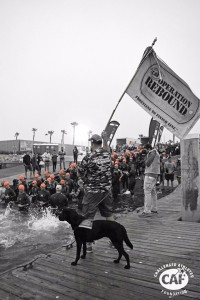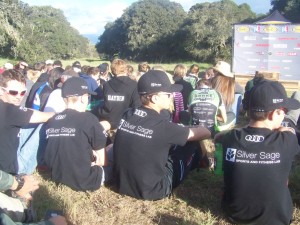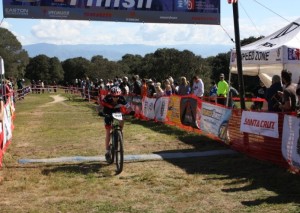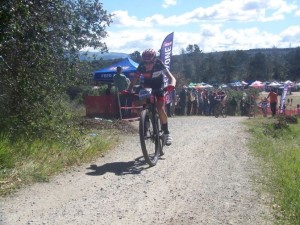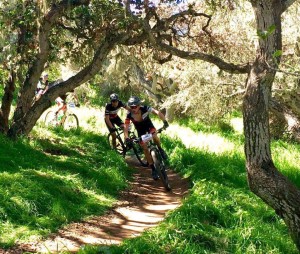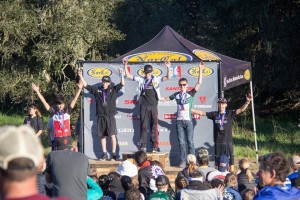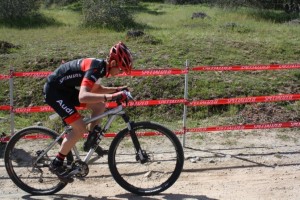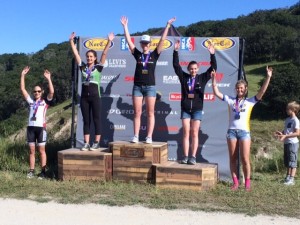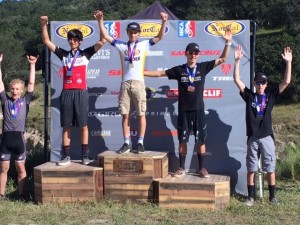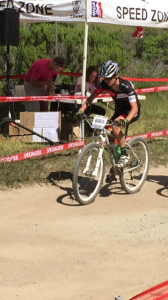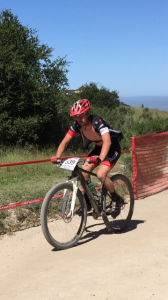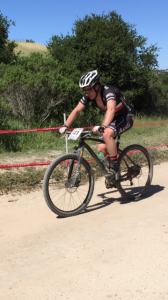Surprising myself – Xterra West Championships
Contributed by Sian Turner, Silver Sage and O2fit-awesome-athlete! I love those races when as a result of consistent diligent training (and having fun while we are at it) we surprise even ourselves with our performance and results. Sian did just that this past weekend at the Xterra West Championships taking a much deserved win! Read on…
Every year I say I am not going to go to the Xterra West champs in Vegas, but for the 6th year in a row I found it on my schedule. The course is a little strange, but over the last 6 years I have become familiar enough with it that I’m starting to like it. It changes slightly each year, for the better I think and I’ve gradually come to learn how to embrace it’s weirdness and race it for what it is. I’ve been mixing up Xterra racing with endurance mountain biking for the last couple of seasons – I keep trying to make a decision on which to focus on but can’t quite let either one go. Last season tuned out pretty successfully by splitting my season up into parts, training as a triathlete through until the Xterra West Champs in April, then becoming a mountain biker for the summer for the Leadville 100 MTB, before hitting the big races at the end of the Xterra season – the Xterra US National Champs, and the World Champs in Maui. Julie of O2Fitness was on board with this same plan again this year as yet again, while I kind of feel myself being pulled towards being a full time mountain biker, I can’t let Xterra go – I love it too much!
For the last couple of years, I’ve had to work a week long trade show in Las Vegas leading up to this race – far from an ideal situation – and I’ve had pretty flat legs by the time the race came around after a long week; but this year, having exited the world of high tech sales engineering work (for now at least), I had a far more ideal lead in to this race. I was coming off a solid performance at the Sea Otter Classic MTB XC race the weekend before so knew I had a good bike performance in me, but my swim and run abilities were a little unknown. Debby Sullivan and I hatched a plan to make the 8 hour drive through nowhereville Nevada, leaving early enough on the Thursday before the race to get to the race venue in time for a post travel ride of the bike course. This worked out really well; we got to drive in daylight and arrived by 3pm, our legs happy to be out of the car and on bikes for an hour, before finding some dinner and hitting our pillows at an embarrassingly early time even for triathletes! We stayed with two of my Braveheart teammates – Tammy Tabeek, and Xterra World champ Lesley Paterson, who showed up last minute with a plan to swim one-armed due to a still healing shoulder fracture, but with piles of energy and excitement that she just had to channel into a race – she’d won Xterra Costa Rica with one arm so she could win Vegas too. I think this is why I can’t stay away from Xterra, however much Mountain Biking pulls me in, I just love the friends I have found in Xterra – it’s the people that make it addictive.
Another pre-ride of the course on Friday morning got the legs ready to race, and we all holed up in our apartment for the afternoon to rest up and get our minds focused. Race morning appeared before we knew it and we each went about our preparation and headed to transition. The Pro field at this race goes of 45minutes ahead of the Age Groupers, so I got to watch the Pro swim and be there to help give Lesley some splits on her one-armed swim vs. the rest of the two-armed Pro field. Incredibly, with a modified two armed style, she was just 50seconds off the main pack exiting the water – they were in trouble – good luck staying ahead of Lesley’s Bike and Run combo! Watching that performance really gave me the race mindset and when our swim start came around, I was ready to go and see what I could do. Julie has provided me with the tools for a good race strategy – take each part of the course as it comes, stay in the moment – this works whether you are having a good day or not. You can only do what you can at each point in time, no point thinking ahead about what is going to happen later in the race, but do what you can where you are right then. The swim is where I really have to employ this strategy – there is only so much I can do on the swim, having done only ‘just enough’ swim training to have an ok swim; so being smart, sighting well, staying calm and focusing on efficient technique got me out the water in as good a time as I could have expected – 28minutes, ok, respectable, on to the bike.
My legs felt good almost the moment I started pedaling; this could be a good day I thought, but I didn’t let my mind linger on that thought for too long. While I was planning to ride hard and put down a real race effort on the bike, I kept Julie’s words in my head – pedal smooth, no mashing, break the course into sections. I had the tools, now execute. I rode smooth and strong up the first climb, passing numerous other bikers the whole way, but not taking much note of which age groups they were in or who they were, I was focused on what I was doing. I rode the steep loose parts of the climbs really well, then let loose on the fast downhills, trusting my Scott Spark’s suspension and stability to carry me safely through the loose rubble of the desert. I rode the first lap clean and fast and when only 46 minutes had passed heading into the second lap, with my body still feeling great, I knew I was onto a good bike time. Last year’s 1hr50min on this course last year was being crushed and I knew it. I pushed onto the second lap, still riding smooth and passing a few more girls who had some good time on me out the water. I was moving well and was soon only finding men out on the course – I wonder which girls are ahead of me? At the end of the bike I came across a girl in my age group, I made the pass before transition and headed out onto the run ahead of her, but not by much. I wondered whether there were more in our age group ahead of us or not? My bike computer stopped at 1hr32 – that’s quite a chunk faster than last year – the course was riding fast and the weather was much more amenable to fast times, but still, nearly 20minutes, I had to be somewhere near the pointy end of the race.
Beginning the run, I could not believe how good I felt, no heavy legs, no out of control breathing, I could actually get settled into a good pace up the paved road towards the dirt and think about how to attack the run, rather than just knowing I would find a way to struggle through it. The girl in my age group I had just passed, re passed me near the start of the run looking strong. I stayed focused on me, taking each hill on the run as it came; she made a gap initially but it wasn’t getting bigger, I could still see her and I wasn’t going to let her go easily. I was running strong, even the super steep hills that I’d had to walk numerous times in the past, energy levels were good and I thought about when and how I would try and close the gap. I knew the run course well so knew how long I had to reel her back in, but I also knew I had made poor decisions in the past about when to make my move. At Sea Otter just the previous weekend, I had finished 3 seconds off the podium due to not attacking at the right time – I made a pact with myself about halfway through the run that I was not going to let that happen again! I told myself that passing the girl in front of me was either the age group win, or a slot to the World champs in Maui – I had no idea if that was true, we could well have been running in 3rd, 4th, 5th place for all I knew, but a strong mind was what was going to get me back to her. Coming into the long sand pit we’d already biked down twice and now had to run down, I got passed by a strong running 25 year old – I couldn’t hang onto her but her speed did help me pick up a few more yards on closing the gap on my age group competitor. With a couple of miles to go, the gap started coming down and I knew I had enough left to catch her; I focused on increasing my stride length – every inch was going to count here if I was going to get her before I ran out of real estate. I drew on coach Julie’s words as well as asking myself ‘what would Lesley do?’ – she’d lay down the hammer, that’s what – no way she’d let her get away! I was nearly on her heals with just a short piece of dirt, then a quarter mile of pavement left, I came across Jay, our Braveheart Xterra Wetsuits guru, on the final lap of his bike – he could see that I was chasing and it gave me an extra push – I was going to turn myself inside out to make the pass and if I did that and it failed then fine, at least I’d would have given it everything.
On the last stretch of the run, I sat for a few seconds on her heals, gathered myself and set off on a 400m effort down the pavement to the finish line, eyes forward, no looking back – I had no idea if she had come with me or not, I just remembered the 400m repeats I had cursed in training but knew I had survived. I pulled ahead and made it to the finish without my legs or mind giving up, I’d made the pass I’d been tracking down for the whole run but still had no idea what that meant in terms of my finish position. Turned out it was for the age group win – something I’d not come close to here before – I was also the 3rd overall amateur and had laid down the fastest amateur bike split, back up by my best ever Xterra run. I placed 13th overall female meaning that I had surpassed a few Pro times as well. I’d surprised myself – I didn’t know I had that race in me, but regardless of positioning I was most proud of my mental strength on the run – I could so easily have let it go, and last year’s me quite possibly would have.
Usually I learn far more from races filled with mistakes and what-if’s, but actually, the lessons here are many as well – I proved a lot to myself and gained confidence for the rest of the season. The carefully designed training by Julie for the winter, building on a great 2014, is starting to show and the year has barely begun. Xterra will take a back seat now until US Nationals in September and Worlds in November (it’s a long season this year!), while I head off into the endurance mountain bike world to give Leadville another shot, and also this year the Park City Point to Point race (75 miles of singletrack).
It takes a team to put together performances like this; thanks to Julie at O2fitness for a training plan I trust and most importantly enjoy, my husband Dennis for supporting me in my crazy athletic exploits, my Braveheart team for giving me inspiration and belief – along with a kick-ass Scott Spark with ENVE wheels to race, Xterra Wetsuits, On Running, Oakley, Tommie Copper, and PowerBar. And thanks to Debby for making the road trip so fun – and even the drive back through gale force winds and torrential rain straight after the race, but it sure was nice to get home that night! I’m sure I forgot someone so thanks to them too!






